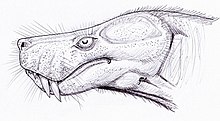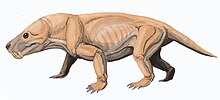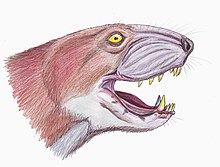Therocephalia
| Therocephalians | |
|---|---|

| |
| Life restoration of two representatives of the early therocephalian genus Alopecognathus | |
| Scientific classification | |
| Domain: | Eukaryota |
| Kingdom: | Animalia |
| Phylum: | Chordata |
| Clade: | Synapsida |
| Clade: | Therapsida |
| Clade: | Eutheriodontia |
| Clade: | †Therocephalia Broom, 1903 |
| Subtaxa | |
| |
Therocephalia is an
The fossils of therocephalians are numerous in the
Anatomy and physiology

Like the
The later therocephalians included the advanced
Several more specialized lifestyles have been suggested for some therocephalians. Many small forms, like ictidosuchids, have been interpreted as aquatic animals. Evidence for aquatic lifestyles includes
Many small therocephalians have small pits on their snouts that probably supported
Classification

The therocephalians evolved as one of several lines of non-mammalian
While common ancestry with cynodonts (and, thus, mammals) accounts for many similarities between these groups, some scientists believe that other similarities may be better attributed to
Taxonomy

Therocephalia was first named and conceived of by
At the same time, the small 'advanced' therocephalians now classified under Baurioidea were often regarded as belonging to their own subgroup of therapsids distinct from therocephalians, the

Various therocephalian subgroups and clades have been proposed since the group was named, although their contents and nomenclature have often been highly unstable and some previously recognized therocephalian clades have turned out to be artificial or based upon
In another example, the name 'Pristerognathidae' was extensively used for a group of basal therocephalians for much of the 20th century, but it has since been recognised that the name Scylacosauridae holds precedent for this group. Furthermore, the scope of 'Pristerognathidae' was unstable and variably was limited to an individual subgroup of early therocephalians (alongside others such as Lycosuchidae, Alopecodontidae, and Ictidosauridae) to encompassing the entirety of early therocephalians.[10] Similarly, various names have been used for therocephalians corresponding to the family Adkidnognathidae in 20th century literature, including Annatherapsididae, Euchambersiidae (the oldest available name) and Moschorhinidae, and members have often had a confused relationship to whaitsiids. Consensus on the name and contents of Akidnognathidae was only achieved in the 21st century, asserting that a family-level group is established on the oldest referable genus and thus Akidnognathidae takes precedent for this group of non-whaitsioid eutherocephalians.[11]
On the other hand, some groups previously thought to be artificial have turned out to be valid. The aberrant therocephalian family Lycosuchidae, once identified by the presence of multiple functional

Modern therocephalian taxonomy is instead based upon
Phylogeny
Early phylogenetic analyses of therocephalians, such as that of Hopson and Barghusen (1986) and van den Heever (1994), recovered and validated many of the therocephalian subtaxa mentioned above in a phylogenetic context. However, the higher-level relationships were difficult to resolve, particularly between the subclades of Eutherocephalia (i.e. Hofmeyriidae, Akidnognathidae, Whaitsiidae and Baurioidea). For example, Hopson and Barghusen (1986) could only recover Eutherocephalia as an unresolved polytomy.[13] Despite these shortcomings, subsequent discussions of therocephalian relationships relied almost exclusively on these analyses.[11] Later analyses focused on the relationships of early cynodonts, namely Abdala (2007) and Botha et al. (2007), included some therocephalian taxa and supported the existence of Eutherocephalia, but also found cynodonts to be the sister taxon to the whaitsiid therocephalian Theriognathus and thus rendering Therocephalia paraphyletic.[20][21]
Later phylogenetic analyses of therocephalians, initiated by Huttenlocker (2009), emphasise using a broader selection of therocephalian taxa and characters. Such analyses have reinforced Therocephalia as a sister clade to cynodonts, and the monophyly of Therocephalia has been supported by subsequent researchers.[11][7]
Below is a cladogram modified from an analysis published by Christian A. Sidor, Zoe. T Kulik and Adam K. Huttenlocker in 2022, simplified to illustrate the relationships of the major recognised therocephalian subclades.[22] It is based on the data matrix first published by Huttenlocker et al. (2011),[8] and represents the broad topologies found by other iterations of this dataset, such as Sigurdsen et al. (2012), Huttenlocker et al. (2014), and Liu and Abdala (2022).[23][24][17] An example of the lability of these relationships is demonstrated by Liu and Abdala (2023), who recovered an alternative topology with Chthonosauridae nested deeply within Akidnognathidae.[25]
Therapsida
|
| |||||||||||||||||||||||||||||||||||||||||||||||||||||||||||||||||||||||||||||||||||||||||||||||||||||||||||||||||||||||||||||||||||||||||||||||||||
Below is a cladogram modified from Pusch et al. (2024) analysing the relationships of therocephalians and early cynodonts. Their analysis focused on including endocranial characteristics to help resolve the relations of therocephalians and cynodonts to supplement previous analyses that relied almost entirely on superficial cranial and dental characteristics that are subject to convergent evolution, and as such only includes taxa with available applicable data. Of these, only four therocephalians could be included. However, they each represent four major groups within therocephalian phylogeny: the two 'basal therocephalians' Lycosuchus (Lycosuchidae) and Alopecognathus (Scylacosauridae) and two derived members of Eutherocephalia, Olivierosuchus (Akidnognathidae) and Theriognathus (Whaitsiidae).[6]
Notably, their analyses consistently found cynodonts and eutherocephalians to be sister taxa, with the basal therocephalians Lycosuchus and scylacosaurids in a more basal position, rendering therocephalians as they are traditionally conceived paraphyletic. This differs from previous proposals of a paraphyletic Therocephalia which typically regarded cynodonts as being closest to derived whaitsiid therocephalians.[6]
|
Traditional therocephalians |
See also
- Evolution of mammals
- List of synapsids
References
- ^ doi:10.1146/annurev.ecolsys.32.081501.114113. Archived from the original(PDF) on 2012-03-21.
- ^ S2CID 128958135.
- ^ Tatarinov, L.P. (1994). "On the preservation of rudimentary rostral tubular complex of crossopterygians in theriodonts and on possible development of the electroreceptor systems in some members of this group". Doklady Akademii Nauk. 338 (2): 278–281.
- PMID 28187210.
- Science Daily.
- ^ PMID 38444024.
- ^ ISBN 9783110275902.
- ^ S2CID 129242450.
- PMID 30911058.
- ^ a b c Van den Heever, J. (1987). The comparative and functional cranial morphology of the early Therocephalia (Amniota: Therapsida) (Ph.D. thesis). University of Stellenbosch.
- ^ .
- ISBN 9780124041202.
- ^ a b Hopson, J. A.; Barghusen, H (1986). "An analysis of therapsid relationships". In Hotton, N.; MacLean, P. D.; Roth, J. J.; Roth, E. C. (eds.). The ecology and biology of mammal-like reptiles. Washington: Smithsonian Institution Press. pp. 83–106.
- ^ van den Heever, J. A. (1980). "On the validity of the therocephalian family Lycosuchidae (Reptilia, Therapsida)". Annals of the South African Museum. 81: 111–125.
- ISBN 978-0-7972-0498-0.
- S2CID 129323281.
- ^ PMID 35857894.
- PMID 29900076.
- PMID 30809450.
- S2CID 83999660.
- .
- S2CID 250663346.
- S2CID 84457790.
- PMID 24498335.
- hdl:10539/35706.
External links
 Media related to Therocephalia at Wikimedia Commons
Media related to Therocephalia at Wikimedia Commons Data related to Therocephalia at Wikispecies
Data related to Therocephalia at Wikispecies










